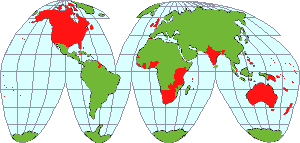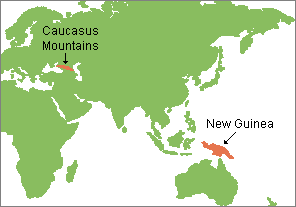Linguists
![]() estimate that there are about 6,000-7,000 different
languages spoken in the world today. The imprecision in this estimate is largely due
to the fact that some dialects are in the process of diverging and it is not clear that
they have reached the stage of being separate languages. If two people find each
other's speech unintelligible, they are usually thought to be speaking different languages
rather than dialects.
estimate that there are about 6,000-7,000 different
languages spoken in the world today. The imprecision in this estimate is largely due
to the fact that some dialects are in the process of diverging and it is not clear that
they have reached the stage of being separate languages. If two people find each
other's speech unintelligible, they are usually thought to be speaking different languages
rather than dialects.
There
are about 200 languages that have a million or more native speakers.
Mandarin
Chinese
![]() is the most common, being spoken by around 874,000,000
people as a native language. English is a distant
third with approximately 341,000,000
native speakers.
is the most common, being spoken by around 874,000,000
people as a native language. English is a distant
third with approximately 341,000,000
native speakers.
| The Most Common Languages in the World | |||
| Language |
Approximate number Of NATIVE Speakers (in the year 2000) |
COUNTRIES WITH SUBSTANTIAL NUMBERS OF NATIVE SPEAKERS |
|
|---|---|---|---|
| 1. | Mandarin Chinese | 874,000,000 | 16 |
| 2. | Hindi (India) | 366,000,000 | 17 |
| 3. | English | 341,000,000 | 104 |
| 4. | Spanish | 322-358,000,000 | 43 |
| 5. | Bengali (India and Bangladesh) | 207,000,000 | 9 |
| 6. | Portuguese | 176,000,000 | 33 |
| 7. | Russian | 167,000,000 | 30 |
| 8. | Japanese | 125,000,000 | 26 |
| 9. | German (standard) | 100,000,000 | 40 |
| 10. | Korean | 78,000,000 | 31 |
| 11. | French | 77,000,000 | 53 |
| 12. | Wu Chinese | 77,000,000 | 1 |
| 13. | Javanese | 75,000,000 | 4 |
| 14. | Yue Chinese | 71,000,000 | 20 |
| 15. | Telugu (India) | 69,000,000 | 7 |
|
Note:
If the 15 major variants of Arabic are
considered one language, Arabic is the 6th most common language in the world having 198-201,000,000 native speakers with substantial numbers in at least 46 countries. Source: Ethnologue Volume I: Languages of the World, 14th ed. (2000). These statistics are only rough approximations in most cases. |
 |
|
Countries in Which English Is an Official |
English is far more world wide in its distribution than all other spoken languages. It is an official language in 52 countries as well as many small colonies and territories. In addition, 1/4 to 1/3 of the people in the world understand and speak English to some degree. It has become the most useful language to learn for international travel and is now the de facto language of diplomacy. In 2001, the 189 member countries in the United Nations were asked what language they wish to use for communication with embassies from other countries. More than 120 chose English, 40 selected French, and 20 wanted to use Spanish. Those who wanted English to be the common language included all of the former Soviet republics, Viet Nam, and most of the Arab world. English is also the dominant language in electronic communication, particularly on the Internet. However, the percentage of Internet users who are not native English speakers is increasing rapidly, especially in Asia. In fact, China estimated in 2008 that there are now more people who have online access in their country than in the U.S., which had been the global leader in Internet access.
In reality, the distribution of languages globally is very complex and difficult to easily describe. Numerous migrations of people over the last several centuries have resulted in most large nations now having many different languages. There are at least 165 languages spoken in the United States today. Consequently, it is somewhat misleading to describe the U.S. as being an English speaking country. The same caution applies to other multicultural nations as well.
Some
parts of the world have unusually high concentrations of different languages.
There are around 900 native languages spoken by the
5-10 million people of New Guinea
![]() and its
neighboring islands. That is roughly 1/6 of all languages being spoken by far less
than 1% of the world's people. Other language high density areas have been native California
and the Caucasus Mountains north of Turkey and Iran.
and its
neighboring islands. That is roughly 1/6 of all languages being spoken by far less
than 1% of the world's people. Other language high density areas have been native California
and the Caucasus Mountains north of Turkey and Iran.

The majority of
the languages in the world are unwritten and many of them are disappearing.
About 1/2 of the world's languages are no longer spoken by children. This is the
first step in the extinction of a language. About 2,000 languages now have less than
1,000 speakers. The most threatened are the indigenous languages of Australia and
the Americas. By the end of
the 20th century, about 200 Australian languages
survived, but more than 1/2 had less than 10 speakers. Two dozen had
a single elderly speaker. Young
Aborigines
![]() now predominantly speak English, especially in urban areas. There has been a similar pattern in
California where Indian languages disappeared at
the rate of nearly one
a year during the late 20th
century. Globally, the rate of language loss
now is one every two weeks. The areas where indigenous languages are
being lost the most rapidly are central South America, Oklahoma and the
American Southwest, the Northwest coastal region of the U.S. and
Canada, eastern Siberia, and northern Australia.
now predominantly speak English, especially in urban areas. There has been a similar pattern in
California where Indian languages disappeared at
the rate of nearly one
a year during the late 20th
century. Globally, the rate of language loss
now is one every two weeks. The areas where indigenous languages are
being lost the most rapidly are central South America, Oklahoma and the
American Southwest, the Northwest coastal region of the U.S. and
Canada, eastern Siberia, and northern Australia.
|
aboriginal language spoken by only one elderly man. This link takes you to an external website. To return here, you must click the "back" button on your browser program. (length = 3 mins, 50 secs) |
There are no "primitive" languages. All languages have a system of sounds, words, and sentences that can adequately communicate the content of culture. The languages of the so-called "primitive" peoples are often very complex in their grammatical structures. There seems to be no correlation between a language's grammatical complexity and the technological level of a society or other aspects of culture. However, cultures that have more complex, diverse economies and advanced technologies have larger vocabularies. For instance, English has roughly 615,000 non-technical words. If slang and specialized technical words are added, English has more than 2,000,000 words and is growing at a rate of hundreds to thousands every year. By comparison, German has about 185,000 non-technical words, French may have less than 100,000, and Spanish even fewer. The major reason that English has so many more non-technical words is the fact that as it evolved from its Germanic roots, it acquired words from more than 240 other languages. However, it is unlikely that any one individual knows the meaning of all English words. Most Americans only use 800-1,000 words in everyday conversation. A typical American college student knows 20,000-30,000 words by the time he or she graduates. While this is 20-37 times more than the average person who has not gone to college, it is still less than 2% of all English words.
Every language can create new words to describe new situations and objects. Therefore, it is not surprising that all languages change through time. None is static. However, they change at different rates at different times in response to new social, cultural, and environmental situations. Some nations strongly resist the acquisition of new words from other languages. This has been the case with the French government's response to the relentless invasion of English words in recent decades, especially in pop culture and technology. However, young people in most developed nations eagerly embrace new words regardless of attempts by their governments to retain "language purity."
NOTE: Counting words in a language for comparison with other languages is a difficult and imprecise task at best. For instance, a verb could be counted as a single word or each conjugation of it could be counted as a separate word. Likewise, it is not clear whether one should count words that have been borrowed from other languages or antiquated word forms that are no longer in common use. It is also unclear how commonly used a slang or technical word must be before it is counted. Relying on dictionaries for word counts is unlikely to be adequate since many words are never included.